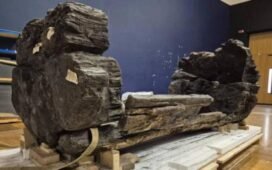A new archaeological study has come to some incredible conclusions on the dramatic Roman siege of Masada, the legendary stronghold which served as the stage for the last stand of Jewish rebels against the Roman Empire almost 2,000 years ago.
The prevailing narrative suggested a protracted siege lasting up to two years, with glorious battles and heroic sorties. But the latest findings claim that the efficient Romans completed this siege within weeks, which aligns with the broader view that, while the siege was a significant military operation, it wasn’t the drawn-out epic previously imagined.
When you consider the Roman constructions that went on to achieve victory – a huge ramp and a wall that circumnavigated the whole base of Mount Masada, it would seem an impossible task to complete in just a couple of weeks. However, the researcher’s meticulous surveys and high-tech analysis have brought about this conclusion.
Modern Tech: Upsetting Ancient Mythology
The dramatic story of the siege, culminating in a mass suicide of the defenders to avoid capture, has long been a cornerstone of Jewish and Israeli history. The research, published in the Journal of Roman Archaeology, was led by a team of experts headed by Hai Ashkenazi from the Israel Antiquities Authority and Goethe University Frankfurt. They employed cutting-edge technology, meticulous surveys, and 3D modelling – to give us a fresh perspective on the ancient battlefield surrounding Masada.

Modern day view from Masada, including the siege ramp and other Roman siege installations at the base. (LevT/Adobe Stock)
Roman Siege Tactics at Masada
The siege of Masada, which occurred around 73 or 74 AD, marked the climactic end of the First Jewish Revolt (66 AD onwards) against Rome. While the fortress itself has been thoroughly excavated and studied over the years, the Roman siege system encircling it hadn’t gotten as much attention from archaeologists – until now.
This new study is here to change that, diving deep into the strategies and tactics the Romans used to overcome the defenses of this formidable fortress. Armed with a mix of high-tech tools – think 3D photogrammetric modeling and GIS analysis – the researchers zoomed in on the circumvallation wall, military camps, and other structures that played starring roles in the siege.
One of the study’s most surprising revelations concerns the circumvallation wall, which wrapped around Masada’s base, a practice Romans employed to cut off the area under siege, giving those inside no way in or out. This feature stood between 2 and 2.5 meters tall (around 6.5 to 8.2 feet) and wasn’t just a physical barrier. It was a massive psychological weapon, too—a towering reminder to the Jewish defenders that they were up against the full might of Rome.

3D model of Tower 7 and the circular feature to its left (view to the west). (Photograph by H. Ashkenazi/Journal of Roman Archaeology)
The wall wasn’t just for show; it was a tactical masterpiece that allowed the Romans to fend off any desperate counterattacks from inside the fortress.
By meticulously measuring the wall and its towers, the team finally settled some long-running debates among scholars. They found that the total length of the siege wall ran to about 4,300 meters (14107.6 feet), and when you throw in the walls of the military camps, the entire Roman defensive setup stretched to a whopping 6,300 meters (20669 feet), reports La Brujula Verde Magazine.
A particularly clever part of the study was how the researchers used 3D photogrammetric modeling to analyze a 1,100-meter (3608.9 feet) stretch of the wall on its eastern side, which is still in great shape after all these centuries. This approach allowed them to calculate not just the wall’s dimensions but also the sheer amount of work it took to build it.

Masada circumvallation wall and its sections. (Drawing by H. Ashkenazi, Base Map after Netzer Reference Netzer1991, Plan A./ Journal of Roman Archaeology)
Roman Efficiency: A Siege in Weeks, A Porous Fortification
Contrary to the previous idea of a drawn-out, grueling siege, the new data suggests that the Romans constructed this whole siege system, including the wall and camps, in just about two weeks. The entire siege, from start to finish, probably lasted somewhere between four to nine weeks—a far cry from the years-long epic that some had imagined.
The study also digs into the multi-functional nature of the siege system. Beyond its obvious role in keeping the Romans safe from surprise attacks, the wall effectively cut off the fortress from the outside world, blocking any hope of supplies or reinforcements for the defenders.
Dr. Guy Stiebel of Tel Aviv University notes, in an interview with Haaretz:
“The fact that the siege lasted less time than we thought doesn’t make the site less interesting or less important. It still raises questions that are no less exciting. Why did the Romans make this effort, years after the official end of the war, to send 6,000-8,000 soldiers to the middle of the desert? It’s still a huge logistical undertaking. It means it was still very important to them.”

Remains of the Roman camp at Masada. (Peter van der Sluijs/ CC BY-SA 3.0)
The team identified and examined seven different sections of the wall, each custom-designed for its specific location and job. For instance, the eastern section, fortified with 15 towers, was all about keeping a sharp eye on the surrounding plains and stopping any daring escape attempts or rescue missions.
Ashkenazi’s team has certainly stirred the pot with their findings, challenging previous interpretations and sparking new questions. For example, the age-old debate about whether the Romans actually finished their famous siege ramp—and how they finally broke into Masada—is still up in the air. But with the fresh data from this study, there’s plenty of fuel for future research and heated academic debates.
All in all, this study not only gives us a deeper understanding of Roman siege tactics but also highlights the incredible preservation of this ancient war zone, thanks to its remote, arid location. After nearly 2,000 years, Masada continues to reveal its secrets, keeping historians and archaeologists on their toes.
The researchers conclude that:
“…based on our observation that large sections of the eastern wall have disappeared or are covered by colluvial sediments, we argue that substantial erosion has occurred on this side of Masada since the 1st century [AD], further reinforcing the argument that the thesis of Goldfus et al. is inaccurate and that the siege of Masada ended with the breach of its western wall by Roman siege machines.”
Top image: Masada showing the siege ramp built by the Roman army. Source: Neukoln/CC BY-SA 3.0
By Sahir Pandey








